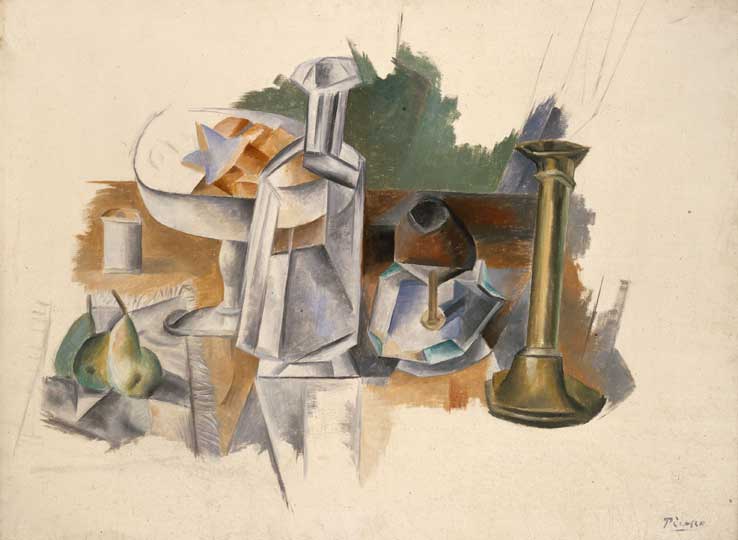Leonard A. Lauder’s promised gift of 81 Cubist works to New York’s Metropolitan Museum of Art (Apollo’s Acquisition of the Year 2013) is now on show. The collection, which he has gathered over 35 years, is the most important of its kind in private hands. The show opens with a blown-up photo taken earlier this year of Lauder’s New York living room, the big back wall hung with eight superb paintings; three by Picasso, five by Braque. It sets the tone. Each of the pictures is part of Lauder’s astounding gift, which the visitor then explores through seven galleries that are similar in size to domestic apartment rooms. Despite the simple museum setting, the experience has the intensity of visiting a private home.
Trees at L’Estaque (summer 1908), Georges Braque © 2014 Artists Rights Society (ARS), New York / ADAGP, Paris
Lauder bought two works on paper by Léger in 1976, and in 1980 went on to acquire Picasso’s Cubist painting Carafe and Candlestick, in which the objects are seen from different viewpoints with a variety of light sources. He soon narrowed his collecting to focus on the movement’s four core exponents: Georges Braque (French, 1882–1963; 17 works in the gift), Juan Gris (Spanish, 1887–1927; 15 works), Fernand Léger (French, 1881–1955; 15 works), and Pablo Picasso (Spanish, 1881–1973; 34 works).
There was a fifth essential person: the visionary dealer Daniel-Henry Kahnweiler, who saw the possibilities of Cubism and championed the artists, his ‘pathfinders’. In 1908 he gave Braque a solo exhibition that included Trees at L’Estaque (1908), a systematic taking apart of naturalistic representation. Matisse famously called Braque’s work ‘painting made with small cubes’. Like the dealer Durand-Ruel before him, Kahnweiler nurtured his artists. He saw them daily, took them sailing, and offered financial support and international promotion. His practical help enabled Juan Gris to flourish and make Cubism his own, as in Still Life with Checked Tablecloth (1915). The year Léger signed on with Kahnweiler, 1913, he painted Houses Under the Trees with its billowing trees and pulsating forms.
Each room of Lauder’s gift tells a chapter of the Cubist story, the paintings so astutely bought that many are benchmarks in the movement’s revolutionary history. Cubism, the most influential avant-garde movement of the first half of the 20th century, first overturned conventions of representation, then began to pave the way for pure abstraction. Picasso and Braque egged each other on. As Picasso recalls, from 1909 to 1911 ‘almost every evening, either I went to Braque’s studio or he came to mine. Each of us HAD to see what the other had done during the day. We criticised each other’s work. A canvas wasn’t finished until both of us felt it was’. Braque’s Still Life with Clarinet and Picasso’s Pedestal Table, Glasses, Cups, Mandolin (both 1911) dissolve their objects to reveal the essential characteristics from various points of view.
Woman in an Armchair (Eva) (1913), Pablo Picasso © 2013 Estate of Pablo Picasso/Artists Rights Society (ARS) New York
After this, the objects in their paintings became increasingly difficult to recognise, then reached the brink of abstraction before both artists drew back and took a new path exploring print media, as in Picasso’s Head of a Man (1912). The next year, he made a breakthrough with Woman in a Chemise in an Armchair. A product of the artist’s voracious visual appetite, it is inspired by African sculpture, erotic penny postcards, an exhibition of paintings by Ingres – everything he clapped eyes on in Paris. This picture, dubbed the first Surrealist painting, juxtaposes the everyday with the bizarre and was shown in London at the International Surrealist Exhibition of 1936, where it was titled Woman with the Golden Breasts.
As he collected, Lauder had his own vision: to gather the best and give it to a museum. The Met has been lucky. Lauder’s outstanding generosity has also been the catalyst for a new research centre for modern art at the museum, where scholars (some on two-year fellowships) will study Cubist archives, documents and works, while also helping transform the modern art holdings and strengthen its presence within the institution’s encyclopedic collections. It kicks off with the Lauder gift’s important catalogue by co-curators Emily Braun (who has a long association with the collection) and the Met’s Rebecca Rabinow.
‘Cubism: The Leonard A. Lauder Collection’ is at the Metropolitan Museum of Art, New York, until 16 February 2015.
Related Articles
